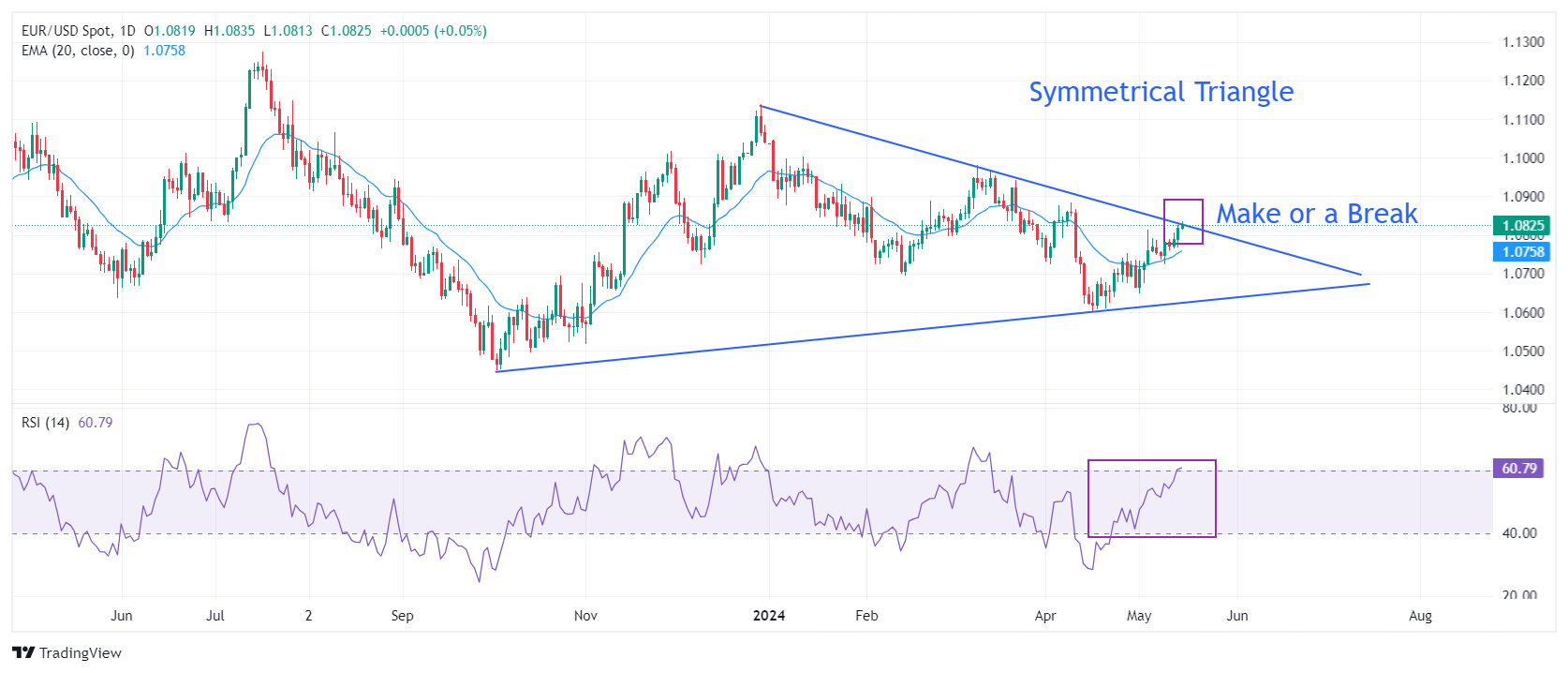- EUR/USD rises to 1.0870, while the US dollar falls due to weak inflation and retail sales data in the United States.
- US inflation data fell in April after remaining stubbornly upward in the first quarter of the year.
- The ECB's Pierre Wunsch expects the probability of two rate cuts to be very high.
EUR/USD refreshes monthly highs near 1.0870 in US American session EUR/USD strengthens as US Consumer Price Index (CPI) softens in line with estimates and sales monthly retailers remain stagnant in April.
The expected decline in price pressures in the US economy, coupled with weak retail sales data, is an unfavorable situation for the US dollar and bond yields. The US Dollar Index (DXY), which tracks the value of the dollar against six major currencies, falls to more than one-month lows around 104.50.
US 10-year Treasury yields have also plunged to 4.36% as weak data is expected to raise expectations that the Federal Reserve (Fed) will begin cutting interest rates from the meeting of September. This will also improve the confidence of Fed policymakers, concerned about stalling progress in the disinflation process, as the three previous reports were more bullish than expected.
Daily summary of market movements: EUR/USD continues to rise and the US dollar falls vertically
- The EUR/USD pair advances to 1.0870 as market sentiment turns extremely bullish due to declining US consumer inflation and stagnating retail sales. S&P 500 futures posted stellar gains early in the American session, showing a sharp improvement in investor risk appetite.
- The annual headline CPI softened as expected to 3.4% from 3.5% in March. Over the same period, core inflation, which strips out volatile food and energy prices, grew in line with estimates, to 3.6%, but slowed from the previous reading of 3.8%. The monthly headline CPI rose at a slower pace of 0.3% from the consensus and previous reading of 0.4% and the core CPI meets estimates of 0.3% but declines from the previous reading of 0.4%.
- U.S. retail sales, which are a leading indicator of consumer spending and provide clues to inflation prospects, remained stagnant in April. Investors expected slower growth of 0.4% in retail sales, down from the previous reading of 0.7%.
- Meanwhile, the Euro remains bullish as investors expect the Fed's longer interest rate hike to slow the pace at which the European Central Bank (ECB) was expected to return to normalization. his politics.
- On Tuesday, Pierre Wunsch, head of ECB monetary policy and governor of the Banque Nationale de Belgique, commented that the first two 25 basis point (bp) reductions in the ECB's official interest rates are almost a “no brainer.” but added that higher rates for longer from the US Federal Reserve could lead to a slower pace of rate cuts.
- Historically, investors bet on the US dollar against the Euro if the policy divergence between the Fed and the ECB increases. A weak Euro brings Eurozone traders a significant volume of business from overseas markets. This could strengthen the economic outlook and translate into higher employment and wage growth, ultimately reinstating price pressures.
- Regarding economic data, Eurostat has published a second estimate of preliminary data for the Gross Domestic Product (GDP) for the first quarter. The GDP report indicated that quarterly and annualized GDP growth were in line with the consensus and preliminary reading of 0.3% and 0.4%, respectively. Although EUR/USD did not react to the second estimate, as investors' attention remains focused on the US CPI data.
Technical Analysis: EUR/USD rises to 1.0870

EUR/USD rises above the 1.0800 round resistance. The asset has advanced to the descending edge of the symmetrical triangle pattern formed on a daily time frame, which is traced from the December 28 high around 1.1140. The ascending edge of the triangle is marked from the October 3 low at 1.0448. The formation of the symmetrical triangle shows a sharp contraction in volatility.
The major currency pair is at a breakout point near 1.0870. A breakout of the symmetrical triangle formation could put the Euro bulls in the driver's seat for a longer period. On the contrary, strong selling pressure could drag them towards the bullish frontier.
The 14-period RSI rises to 60.00. Bullish momentum would be triggered if the RSI remains above these levels.
economic indicator
Consumer Price Index without food or energy (annual)
Inflationary or deflationary trends are measured by periodically adding the prices of a basket of representative goods and services and presenting the data as the Consumer Price Index (CPI). CPI data is collected monthly and published by the U.S. Bureau of Labor Statistics. The annual reading compares the prices of goods in the reference month with the same month of the previous year. The CPI excluding food and energy excludes the most volatile components of food and energy to provide a more accurate measure of price pressure. Generally speaking, a high reading is bullish for the US Dollar (USD), while a low reading is considered bearish.
More information.
Last post: Wed May 15, 2024 12:30
Periodicity: Monthly
Current: 3.6
Consensus: 3.6%
Former: 3 .8
Fountain: US Bureau of Labor Statistics
The US Federal Reserve has the dual mandate of maintaining price stability and maximum employment. According to this mandate, inflation should be around 2% annually and has become the weakest pillar of the central bank's directive since the world suffered a pandemic, which continues to this day. Price pressures continue to mount amid supply chain issues and bottlenecks, with the Consumer Price Index (CPI) at multi-decade highs. The Fed has already taken steps to contain inflation and is expected to maintain an aggressive stance for the foreseeable future.
Source: Fx Street
I am Joshua Winder, a senior-level journalist and editor at World Stock Market. I specialize in covering news related to the stock market and economic trends. With more than 8 years of experience in this field, I have become an expert in financial reporting.







